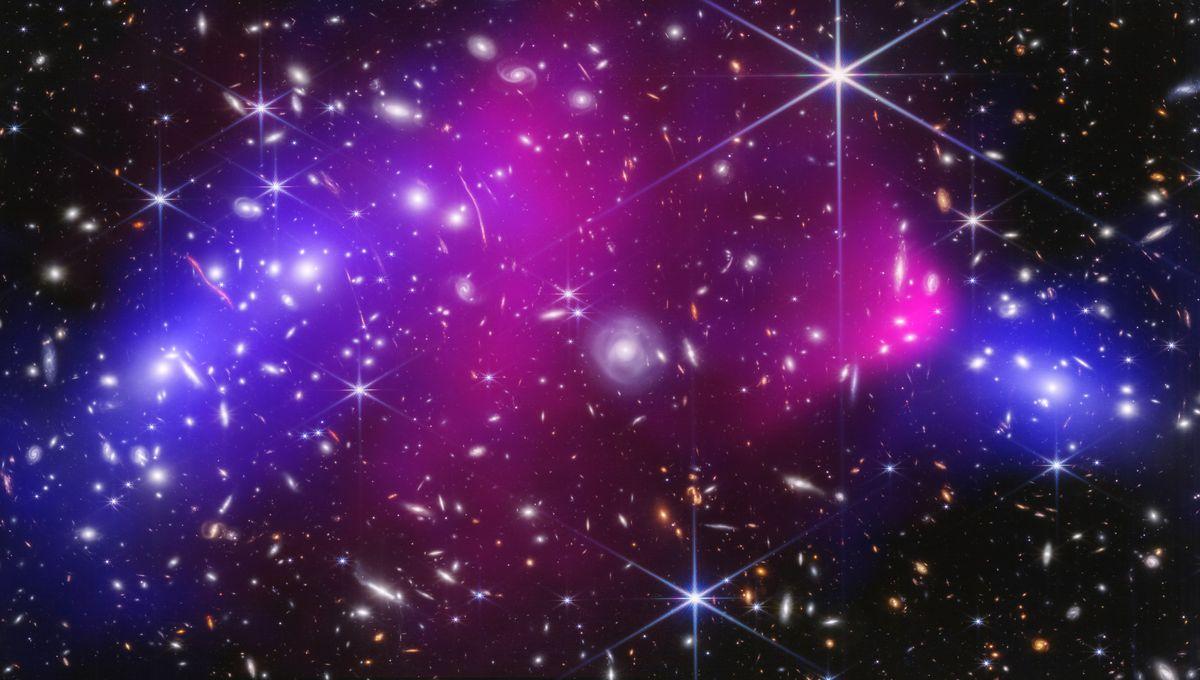Stunning New JWST Observations Give Further Evidence That Dark Matter Is A Real Substance

Stunning New JWST Observations Give Further Evidence That Dark Matter Is A Real Substance
According to our best possible understanding of the universe, regular matter is only a small fraction of the matter-energy content of the universe. The energy we interact with and the matter we are made of and see is at most 5 percent of the total. What’s the rest? We don't know exactly. About 70 percent is called dark energy, responsible for the accelerated expansion of the universe. The rest is dark matter, an invisible substance that only interacts via gravity. New observations from the James Webb Space Telescope (JWST) continue to support this idea.
While dark matter is the accepted likely explanation for what goes on in the universe, it is unsurprising that several scientists do not like it. “There is a mysterious substance whose particles we can’t seem to find and yet it is everywhere. Also, it’s invisible!” The alternative explanation is that our laws of gravity no longer work when we go to galactic scales, and they need to be modified. This is a different copout: “Sure, relativity works well at this scale, but if you let me tweak it until it explains how galaxies move, then we do not need dark matter!” We were balanced in making fun of both dark matter and Modified Newtonian Dynamics (MOND), but now we need to state that, with all its limits, dark matter can explain the peculiarities of several specific objects in space, something that MOND cannot. The Bullet Cluster is among the most notorious of those objects. Galaxy clusters are groups of hundreds, if not thousands, of galaxies. The Bullet is famous because it consists of not just one cluster, but two clusters undergoing a collision. Past evidence has shown that the distribution of the hot gas in the cluster that can be observed in X-rays is separate from the distribution of dark matter, which can be worked out by a method called gravitational lensing. This is because, while the hot gas of the two clusters interacts, dark matter flies past without major changes. “As the galaxy clusters collided, their gas was dragged out and left behind, which the X-rays confirm,” Kyle Finner, study co-author and an assistant scientist at IPAC at Caltech, said in a statement. The full JWST and Chandra image of the Bullet Cluster. Image credit: NASA, ESA, CSA, STScI, CXC, James Jee (Yonsei University, UC Davis), Sangjun Cha (Yonsei University), Kyle Finner (Caltech/IPAC) It's in the distribution of mass that the new JWST observations come in. Any object with mass warps space-time, and if you have objects that are big and dense enough, you can turn space-time itself into a lens. In the image above, you can see subtle and very unsubtle warping of galaxies, and this allows us to infer the distribution of dark matter. “Gravitational lensing allows us to infer the distribution of dark matter,” explained James Jee, study co-author, professor at Yonsei University, and research associate at UC Davis. Jee compared dark matter to crystal-clear water in a pond, with pebbles as the galaxies. “You cannot see the water unless there is wind, which causes ripples. Those ripples distort the shapes of the pebbles below, causing the water to act like a lens.” JWST’s extraordinary near-infrared instrument was used to measure thousands of galaxies and even stars that have been kicked out of their galaxies and now travel across the cluster. This allowed researchers to “weigh” the cluster with much greater accuracy, which confirmed previous findings – especially when it came to the intracluster stars, which can be used as a proxy in tracing dark matter. “We confirmed that the intracluster light can be a reliable tracer of dark matter, even in a highly dynamic environment like the Bullet Cluster,” lead author Sangjun Cha, a graduate researcher at Yonsei University in Seoul, explained. The Bullet Cluster is located 3.8 billion light-years from Earth. The new observations suggest that the large cluster, which is now on the left, might have suffered minor collisions before and after ramming through the cluster on the right. It seems the whole system is a lot more complicated than previously thought. The study is published in The Astrophysical Journal Letters.


